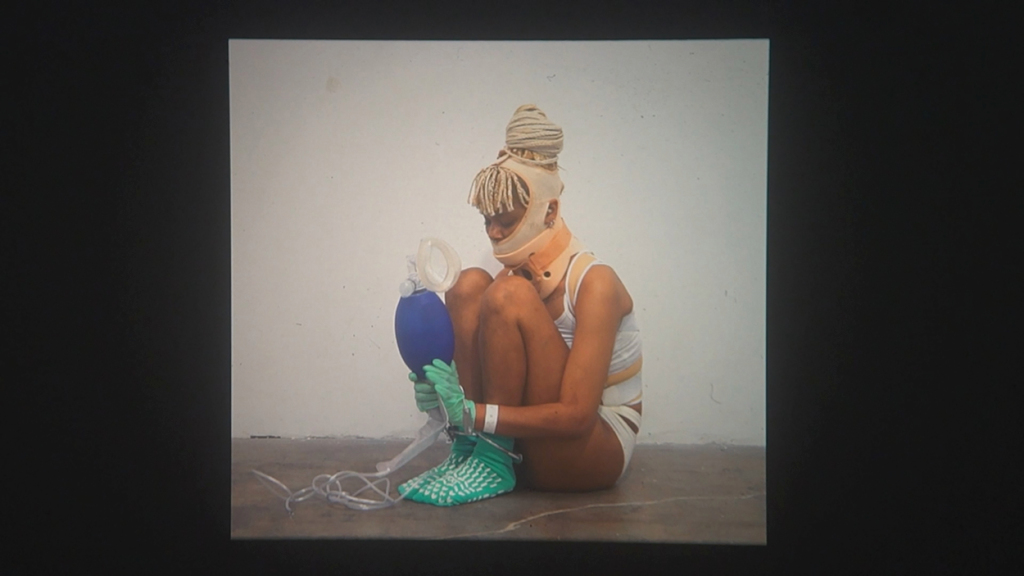 Panteha Abareshi: Methods of Care for the Precarious Body, 2021, video still, 5:50 minutes. Courtesy the artist
Panteha Abareshi: Methods of Care for the Precarious Body, 2021, video still, 5:50 minutes. Courtesy the artist 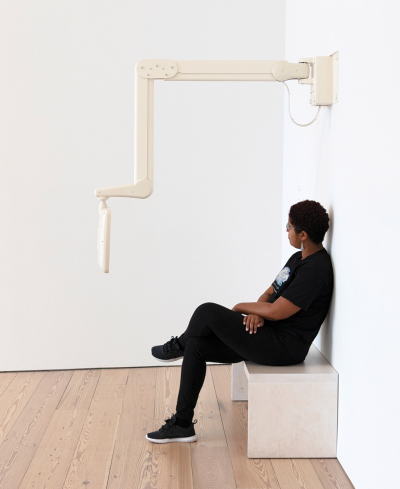 Carolyn Lazard: Extended Stay, 2019, articulating medical arm mount, personal patient monitor, basic cable subscription, infinite duration.; in the Whitney Biennial. Courtesy the artist and Maxwell Graham/Essex Street, New York.
Carolyn Lazard: Extended Stay, 2019, articulating medical arm mount, personal patient monitor, basic cable subscription, infinite duration.; in the Whitney Biennial. Courtesy the artist and Maxwell Graham/Essex Street, New York.
Carolyn Lazard’s installation in the 2019 Whitney Biennial saw a TV monitor attached to a wall by the long arm of an articulated hospital television mount. The Philadelphia and New York–based artist hooked up the museum with cable, and set the monitor to change channels automatically every 30 seconds. Titled Extended Stay, the work was meant to bring hospitalized patients and museumgoers together, allowing them to share the same programs remotely. Connecting the sick and the well through real-time video, Extended Stay speaks to how sick and disabled people have already long practiced many of the new norms that arose in the year 2020, and will continue to do so for years to come.
More than that, Extended Stay addresses the boredom associated with illness—a feeling that many people experienced during quarantine, deprived of the usual outlets for socializing and entertainment. Cable is, of course, a medium in decline, but in hospitals, it persists, a necessary distraction and a reminder of the world outside. The work’s constant channel changing called to mind the experience of being too ill or too medicated to concentrate on much, yet too bored to tolerate zero stimulation. And, by focusing on boredom, Lazard subtly challenged the depictions of hospitals we see on TV, where they are typically portrayed as settings for acute drama, rather than banal, drawn-out interludes.
There have always been, and will always be, chronically ill and disabled artists, and many of them these days cite Lazard as influential in emboldening them both to speak out and in charting new formal strategies for doing so. According to the Centers for Disease Control and Prevention, 51.8 percent of Americans have at least one chronic condition—surely a low number, as the CDC conducted the study using only ten common diagnoses. Today, many people with access to WebMD or toxic op-eds—even those who lack both symptoms and biological expertise—feel entitled to voice their myriad medical opinions. Accordingly, plenty of individuals with chronic illnesses find reason in this attitude to opt for silence.
It isn’t just stigma that makes talking or writing about illness challenging; melodramatic tropes abound to which many sick people simply can’t relate. Writers like Lazard, Anne Boyer, Porochista Khakpour, Susan Sontag, and Leah Lakshmi Piepzna-Samarasinha point out how burdened they feel by the conventions of illness narratives: the pressure to mimic a patient testimonial, the convention of using illness as a device for drama, the knowledge that readers often pity infirm writers and characters. Susan Sontag’s oft-quoted Illness as Metaphor (1978), published following her diagnosis of cancer, makes the case that illness narratives have a profound impact on real life.
That’s why it’s time to find new chronic illness narratives. Those authored by Lazard, and by Panteha Abareshi, Beatrice Adler-Bolton, Jordan Lord, and Guadalupe Maravilla, among others, often purposely focus on the quotidian aspects of sickness. They offer refreshing counterpoints to the melodramatic or confessional modes that have plagued depictions of serious illness in film and literature. These artists also take care to frame healing as an ongoing process, distinct from cure, and to highlight the unique expertise of the chronically ill.
WHO BETTER TO practice healing than the sick, who have likely experimented relentlessly, and who manage their own bodies every day? The El Salvador–born, New York–based artist Guadalupe Maravilla has channeled his experience with cancer and migration into a healing-focused practice. For his exhibition “Planeta Abuelx,” on view this past summer at Socrates Sculpture Park in Queens, he grew food crops and medicinal herbs around one of his “Disease Thrower” sculptures, and hosted occasional healing sound bath sessions, using the sculpture’s gong to create soothing sounds. “Planeta Abuelx” provided a healing space to mourn the elders we lost to Covid-19. The show likened bodily maintenance to cultivating a garden, and Maravilla infused his space for collective grieving with a gentle call to action. “Abuelx,” a term he coined in the absence of a gender-neutral Spanish word for “grandparent,” framed the earth (“planeta”) as a wise elder deserving reverence and care, who in turn provides vital resources for healing.
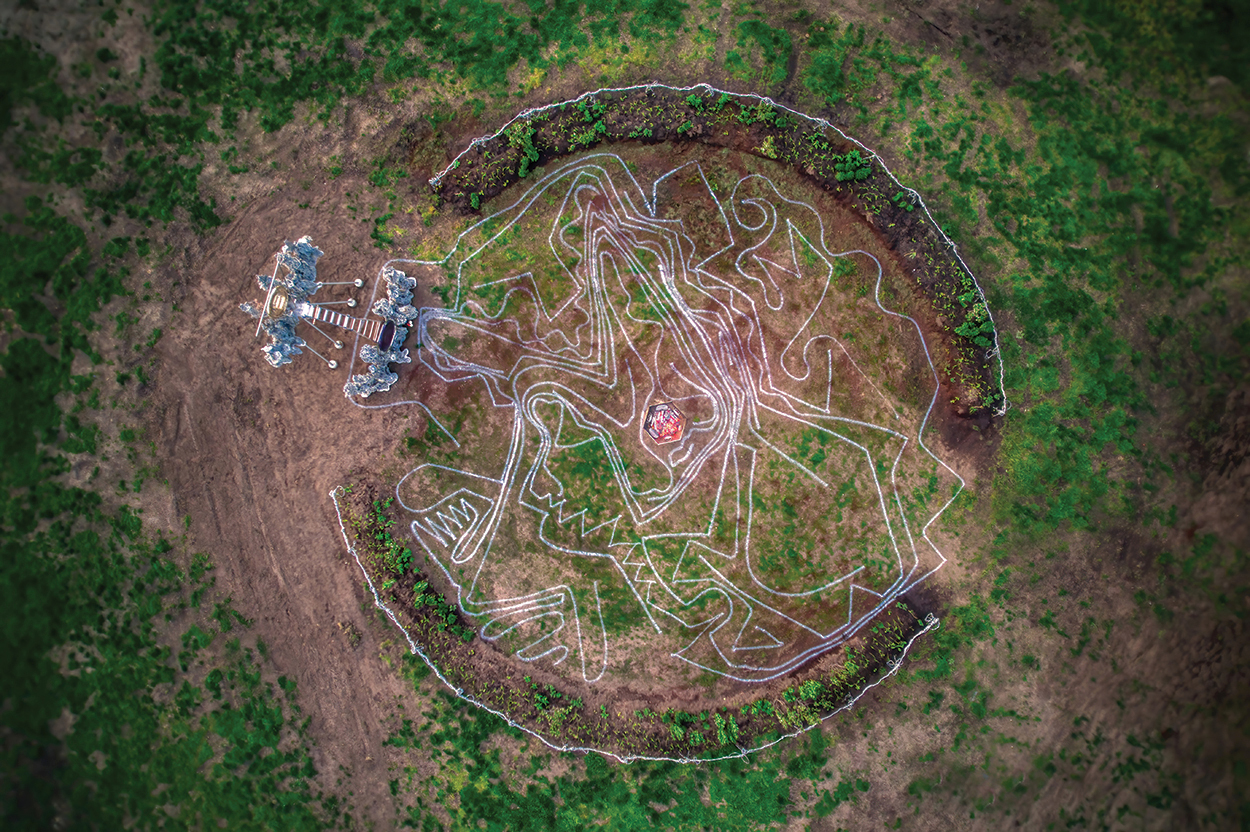 Aerial view of Guadalupe Maravilla’s Tripa Chuca, 2021, at Socrates Sculpture Park, New York Photo Mark DiConzo. Courtesy the artist, Socrates Sculpture Park, and P·P·O·W, New York.
Aerial view of Guadalupe Maravilla’s Tripa Chuca, 2021, at Socrates Sculpture Park, New York Photo Mark DiConzo. Courtesy the artist, Socrates Sculpture Park, and P·P·O·W, New York.
Many aspects of the show, however, were more autobiographical and decidedly less universal. “Before [the pandemic],” Maravilla said during a virtual studio visit, “when I would talk about healing, only certain people were interested—usually those who were really spiritual, or people who had been through a lot of trauma.” Maravilla’s appreciation of nature’s capacity for healing, for example, is deeply rooted in his life. He planted squash—one of the few foods that he could eat after having a portion of his colon removed—around the installation’s periphery, alongside corn and beans. Known as the “three sisters,” this trio of crops forms the foundation of Indigenous agriculture from Mexico to Montana. The plants grow best together, and produce abundance in a manner that benefits both humans and the earth. Botanist Patrick Costello cultivated the medicinal herbs in “Planeta Abuelx.” In aspiring to heal both seven generations back and seven generations ahead, Maravilla highlights the Iroquois seven generations principle—now an environmentalist slogan—as well as the impact that ancestral trauma may have on an individual’s health.
At the age of eight, Maravilla fled the Salvadoran Civil War and immigrated unaccompanied to the US on foot; the journey took two and a half months. Along the way, to pass the time, he played a Salvadoran children’s game called Tripa Chuca (Rotten Guts), in which two players attempt to connect numbered pairs by drawing lines between them without ever allowing the lines to touch or cross. In 2011, at age thirty-five, Maravilla was diagnosed with stage three colon cancer—making the name of his childhood pastime disturbingly on-the-nose—but he has been cancer-free since 2013. Tripa Chuca drawings are a regular motif in his work; Maravilla worked alongside a fellow cancer survivor to create one in the grass at the center of the installation.
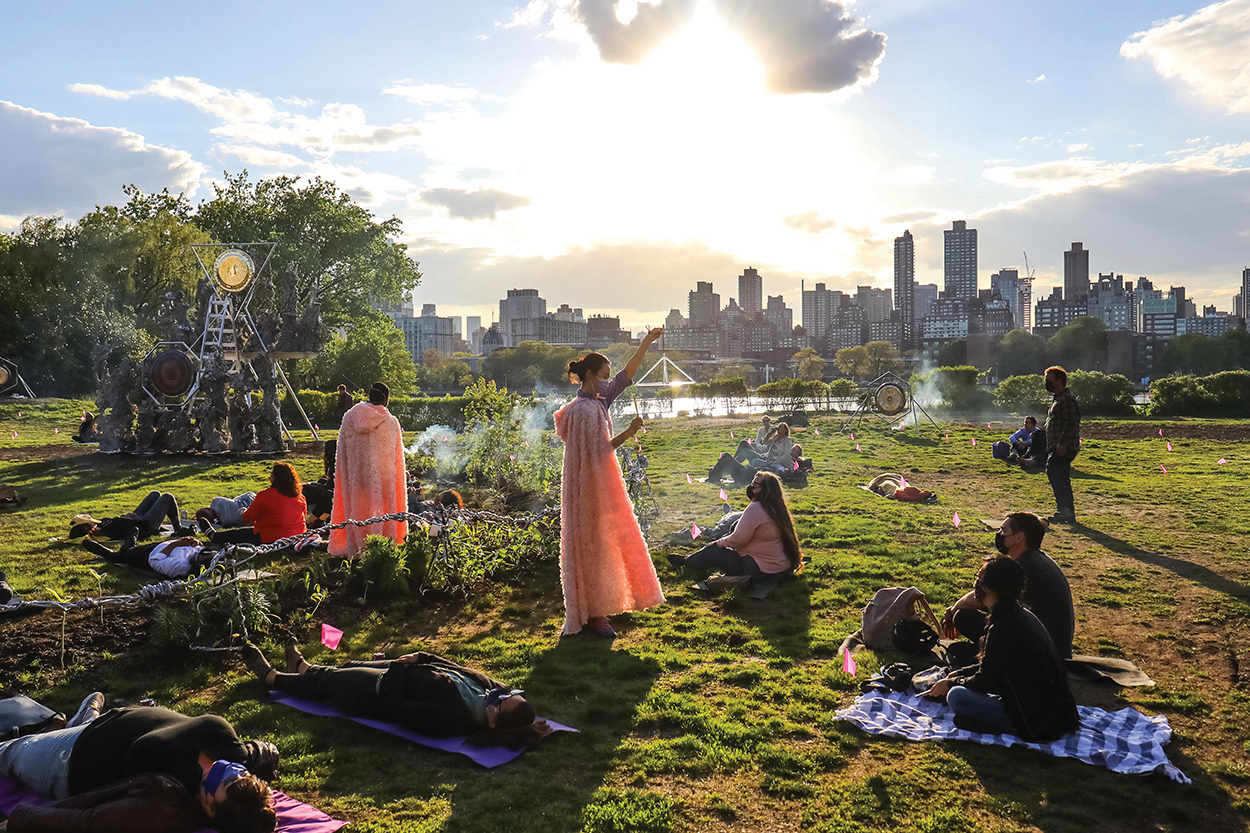 View of Guadalupe Maravilla’s Sound Bath, 2021, at Socrates Sculpture Park, New York. Photo Scott Lynch. Courtesy the artist, Socrates Sculpture Park, and P·P·O·W, New York.
View of Guadalupe Maravilla’s Sound Bath, 2021, at Socrates Sculpture Park, New York. Photo Scott Lynch. Courtesy the artist, Socrates Sculpture Park, and P·P·O·W, New York.
Among Maravilla’s primary audience are those whose lives have been affected by cancer, and some of the healing sound baths he hosted in the park were open only to them. For all the sessions, participants gathered around the 14-foot-high “Disease Thrower” sculpture that Maravilla created for the show. A medly of cast fruits and vegetables that played a role in healing Maravilla’s gut—including squash, coconuts, and papayas—were affixed to an aluminum armature that also incorporates the aforementioned gong and a fire pit. Performers activated both during healing sessions. Maravilla discovered the therapeutic benefit of sound baths during his cancer treatment, and has since frequently shared the practice with his audience. He told A.i.A. that he’s most interested in “providing healing to undocumented or marginalized communities, as well as those who have cancer or other illnesses, because healing has become a commodity, and the people who need it most have the least access to it.” This refers not only to the effects that he believes trauma from generations past can have on the body, but also to material needs, from health insurance to land for growing herbs.
Maravilla’s concern about framing illness as a timely, Covid-related subject—rather than a timeless one echoes something many chronically ill artists have expressed throughout the public health crisis: will major institutions, many of which have reached out to sick and disabled artists for advice on topics from healing to remote access, simply go back to their regular inaccessible programming once the threat subsides? Will the exclusion of disabled artists resume again when their work is no longer relatable to nondisabled audiences? Maravilla’s work also echoes calls from sick and disabled artists to push back on the widespread desire for neat, inspiring narratives about healing or endurance. In Minerva the Miscarriage of the Brain (2020), Berlin-based artist, writer, and musician Johanna Hedva summed up an attitude many of their contemporaries share: “I can’t stand the concept of healing if you don’t also talk about hopelessness, hemorrhaging, the medical-insurance industrial complex, panic, poverty, and boredom.”
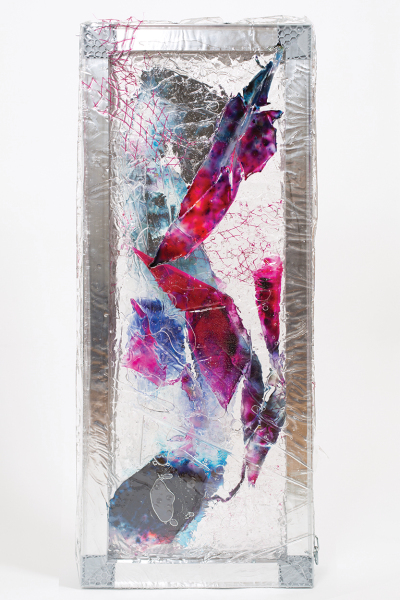 Beatrice Adler-Bolton: Unhealthy for Sensitive Groups, 2018, pigments, prefabricated aluminum stretcher strips, resin, plexiglass, and mixed mediums,43 by 17 by 4 inches. Photo Artie Vierkant. Courtesy the artist.
Beatrice Adler-Bolton: Unhealthy for Sensitive Groups, 2018, pigments, prefabricated aluminum stretcher strips, resin, plexiglass, and mixed mediums,43 by 17 by 4 inches. Photo Artie Vierkant. Courtesy the artist.
CHRONIC ILLNESS OFTEN involves symptom management, coping, or adapting—therapy, rather than healing or cure. It can take years of experimenting before determining whether side effects outweigh benefits. And then, it could all change—when, for example, a pharmaceutical company discontinues a drug. Philadelphia-based painter Beatrice Adler-Bolton had been taking an antibody to manage her autoimmune disease for ten years when, last year, the private insurance company who administers her Medicare discovered they were not legally obligated to pay for it; her condition was so rare that it did not appear on the list of those treatable by the medication. Furthermore, as a disabled person, Adler-Bolton would become ineligible for Medicare coverage if her yearly income exceeded a certain threshold, around $14,000, and the drug’s annual out-of-pocket cost was at least $20,000. Eventually, she moved from New York to Philadelphia, which enabled her to swap plans and get back on her prescription.
Not all the adapting and experimenting that chronic illness engenders is tragic or tiresome. It can also be generative, as we’ve no doubt learned this past year—there are things we will miss about the Covid-era “new normal.” This much is evident in Adler-Bolton’s paintings: her condition, which affects her eyesight, among other things, informs everything about her process. She describes her vision as almost sepia toned, and rather blurry, except in one small spot. Her ability to see varies from day to day, and she is legally blind. Trained as a painter, she is no longer able to create colors by mixing pigments until the hue looks right, so instead, she works with dyes and tints. The process relies on an understanding of chemistry more than on intuition or vision. Adler-Bolton creates abstract forms reminiscent of Helen Frankenthaler’s stains, but in clear plastic surfaces stretched—and sometimes, layered—across aluminum bars. On occasion, plastic water bottle wrappers with legible logos appear: Adler-Bolton saves these when forced to buy overpriced water on planes or in airports, so some of them are European brands. She sees the bottles as symbols of the commodification of our most basic human needs, a topic she confronts quite directly on the podcast “Death Panel,” which she cohosts with artist Artie Vierkant and political scientist Philip Rocco.
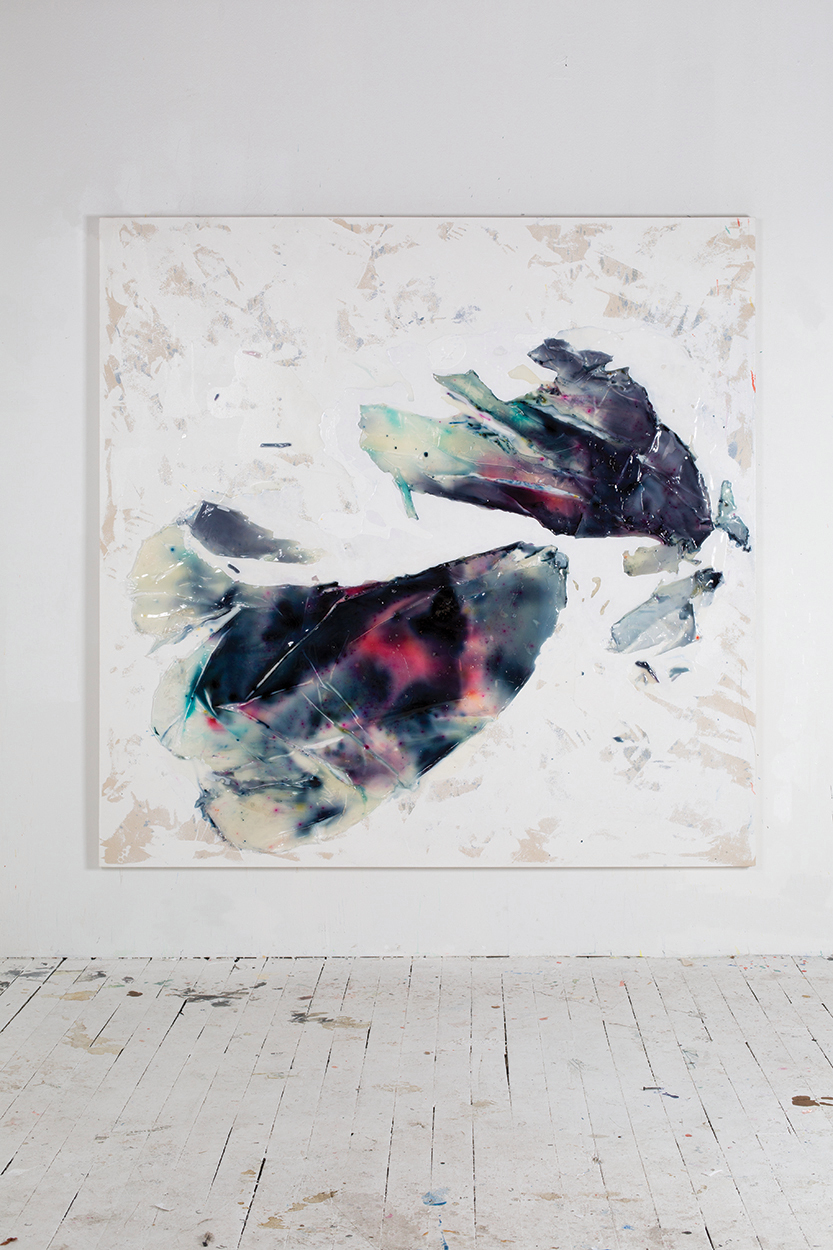 Beatrice Adler-Bolton: No Title, 2017, acrylic polymer, synthetic coal tar pigment (ASTM-A), potassium dihydrogen phosphate, disodium hydrogen phosphate, and silk dye on canvas, 72 by 72 inches. Photo Artie Vierkant. Courtesy the artist.
Beatrice Adler-Bolton: No Title, 2017, acrylic polymer, synthetic coal tar pigment (ASTM-A), potassium dihydrogen phosphate, disodium hydrogen phosphate, and silk dye on canvas, 72 by 72 inches. Photo Artie Vierkant. Courtesy the artist.
While the podcast advocates relentlessly for Medicare for All, the hosts don’t pretend that Western biomedicine could solve everything if only it were universally available. Similarly, Los Angeles–based artist Panteha Abareshi critiques the top-down approach that doctor-patient relationships sometimes take, highlighting the harmful effects of ignoring patients’ expertise concerning their own bodies. Abareshi’s performance Methods of Care for the Precarious Body (2020), documented on video, featured slides from government-subsidized medical education films produced between 1950 and 1970, intended for doctors and nurses. The 35mm slides give instructions in white text on a reddish background, some with violent undertones, like how to EFFECT FULL IMMOBILIZATION OF THE PATIENT and ACHIEVE THE VITAL ALLEVIATION OF CONTROL. These are interspersed with slides that show Abareshi acting as both doctor and patient, contorting to follow the instructions on their own body. Performing live in the solo exhibition “Tender Calamities,” on view this past spring at the Los Angeles Municipal Art Gallery, the artist advanced the slides as they knelt on the floor facing the projection, clad in a variety of braces and other medical appliances—the same ones with which they struggle on-screen. Appearing both on camera and in meatspace, Abareshi called attention to the humanity of the person as medical subject: immobilized, restrained by braces, the artist did not speak, moving only to press the advance button on the slide carousel. The gesture involved a fleshy, breathing reminder of how cameras and medical devices alike can turn a person into a specimen, a disturbing reality that has had dramatic consequences for scores of patients. This is especially true for Black patients like Abareshi, who have historically been subject to medical experimentation.
One episode from this long, dark history is the subject of Lazard’s five-minute video Pre-Existing Condition (2019), which shows records of tests performed on inmates by a University of Pennsylvania dermatologist between 1951 and 1974. The voiceover is a haunting testimony from one survivor-cum advocate: a Black man named Edward Yusuf Anthony. Viewers learn that companies like Pfizer and Johnson and Johnson tested the safety and effectiveness of numerous pharmaceuticals on incarcerated people, taking advantage of their imposed poverty by reimbursing them as little as a dollar. The experiments ended after congressional hearings deemed them a violation of the Nuremberg Code of 1947, but many of the inmates allegedly continue to live with chronic conditions as a result.
Abareshi’s performance also critiques a prevalent medical tendency to “correct” a patient’s body rather than alleviate unpleasant symptoms, such as pain. The instructions the artist appropriates are jarring in their blatant disregard for patient comfort: while several slides explain how to restrain a patient, another (labeled OPTIONAL) reads OTAKING STEPS FOR COMFORT: RELIEF FROM POTENTIAL HURT CAUSED BY CARE. Abareshi still follows the instructions obediently, ensuring, for example, that preventative restraints are tightly secured. The artist’s compliance suggests they know, as experienced patients often do, that they must at least pretend to comply if they want their doctors to take them seriously, even when they have good reason to doubt the efficacy of a procedure. But the artist follows instructions so literally that the result is a caricature.
 Panteha Abareshi: Methods of Care for the Precarious Body, 2021, video still, 5:50 minutes. Courtesy the artist
Panteha Abareshi: Methods of Care for the Precarious Body, 2021, video still, 5:50 minutes. Courtesy the artist
Throughout their practice, Abareshi regularly returns to analog formats, likening the beautiful defunctness of outdated media to chronic illness. Slide projectors derive their aesthetic impact in part from their clunky sound, and from the dust on the image that shows up on the wall, a reminder of the picture’s materiality and fragility. This outdated medium is not the most efficient way to show images, and that’s precisely what makes them so charming: when viewed today, projected slides convey a sense that their preservation involved serious care. In her moving 2018 essay on the history of the healing justice movement, Leah Lakshmi Piepzna-Samarasinha wrote similarly about how sick and disabled people “remake ideas of healing away from being fixed, and toward being autonomously and beautifully imperfect.”
Jordan Lord’s 16-minute video After… After… Access (2018) reflects on how illness is often treated like a liability in the land of lawsuits. On-screen, the artist and filmmaker documents their own open-heart surgery. There is no footage of a surgeon actually operating: the hospital said they’d need a $2 million to $5 million insurance policy for that. “I gave the hospital permission to go inside my body,” Lord recalls in the voiceover, “even though they wouldn’t give me permission to film what happened after.” The formal challenges that accessible filmmaking raises, especially when serving Deaf and blind audiences, are generative for Lord, who often takes on subjects—surgeries, emotions—that cannot be seen or filmed. Instead of the procedure, we see the friends and family who showed up to support Lord before and after the operation, and listen to the risk calculations and other issues they discuss.
Lord’s newest film was made in collaboration with their grandmother, Mimi, who is experiencing lapses in her short-term memory. The work takes up the concept of “liveness” as it pertains both to video and to people. Lord and Mimi made the film throughout the span of their show “Prophetic Memory,” hosted by Artists Space in New York through September 4, and continually updated their process on the institution’s website. The final film premiered in the gallery. Lord’s slow progress toward an in-person installation reflected caution during the city’s gradual reopening. A work in progress as of this writing, Prophetic Memory also considers the elder-care-related woes that Lord and Mimi share, despite their otherwise differing political views. Several clips depict Mimi at her home in Mississippi watching Fox News, where she hears her chosen viewpoint of the world at large. Lord, who feels that the news organization takes advantage of the sort of boredom or isolation common to elderly and disabled people, cites Lazard’s Extended Stay as an influence for “Prophetic Memory.” In other clips, Mimi narrates the countless, moving long-term memories she still has.
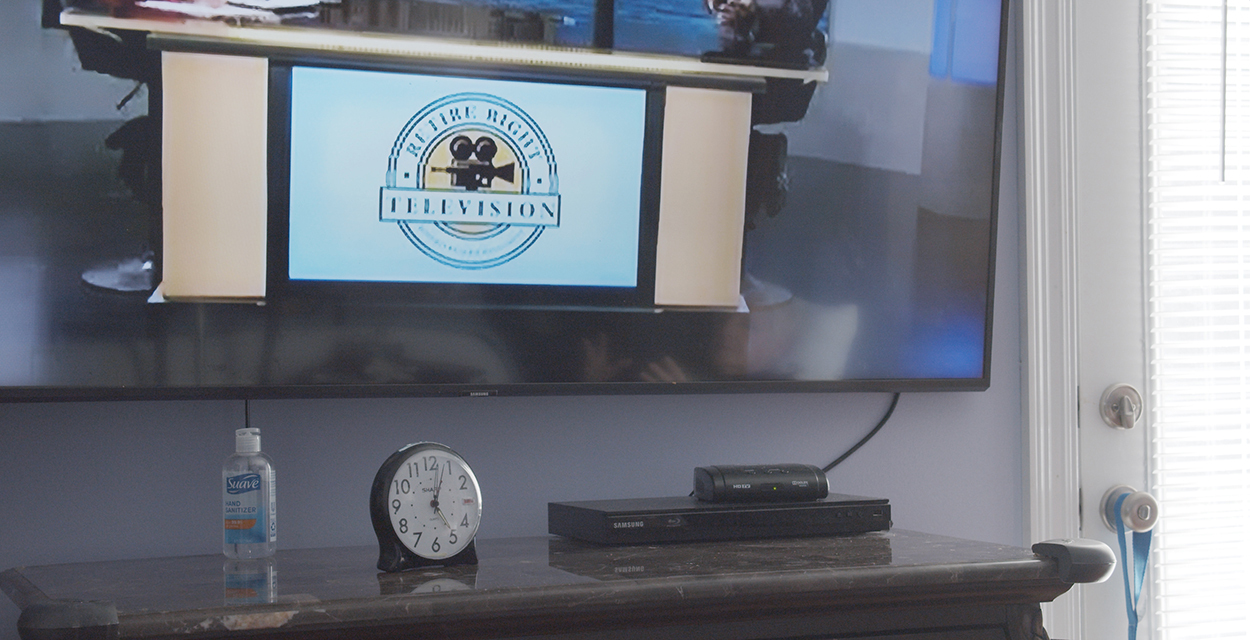 Jordan Lord: Prophetic Memory (still), 2021, video, 36 minutes 15 seconds. Courtesy the artist
Jordan Lord: Prophetic Memory (still), 2021, video, 36 minutes 15 seconds. Courtesy the artist
Lord is adept at allowing subjects—usually family members—to air their own controversial views, and then offering counterarguments with empathy and grace rather than hostility. Filming their working class Southern white family for an art world audience, this is no small feat. Often they film calm and measured disagreements, letting their subjects comment on the footage, and so stand apart from the artist’s worldview. In a voiceover accompanying Shared Resources (2021), a feature about the family’s post-Katrina bankruptcy that screened at the Museum of Modern Art in New York this past spring, Lord’s dad objects to the way he’s portrayed, and in another scene, Lord’s finger is visible over the lens in place of footage that their parents asked the artist to remove. Lord also alludes to the systemic nature of the family’s financial disenfranchisement, even though the other members don’t see it that way. The new film is ultimately meant to exhibit the breadth of Mimi’s person, to portray her as someone who deservedly enjoys her life.
People too readily assume that most chronically ill and elderly people have miserable lives. This is why representations of everyday illness matter tremendously. Such assumptions lead almost all those seeking a label for their symptoms via Dr. Lisa Sanders’s New York Times “Diagnosis” column-turned-Netflix-documentary-series to confess that their biggest fear is contracting something incurable. Although chronic conditions range widely, the symptom management solutions Sanders’s guests are prescribed often tend to be as straightforward as a change in diet or use of a medical device. Similarly, there is a widespread—and understandable—desire to think about the pandemic as an event with a beginning, middle, and end. We are taught to believe that the arc of illness ought to end in cure, though the long-term effects of contracting Covid-19—on individuals and society both—remain unknown. These artists help us see that coping is common, and often more realistic than a neat narrative; that adjusting norms to prioritize health can be generative. They also resist the pressure to romanticize illness, and to create inspiring, uplifting works focused on endurance or overcoming or love in the face of tragedy. The sadness and frustration they do express is usually directed not at their own bodies, but toward the woeful limitations of society’s ableist views, or the discouraging state of US health care. This is almost certainly just the beginning of a movement—there are countless illness narratives that remain to be told.
This article appears under the title “Everyday Illness” in the September/October 2021 issue, pp. 50–57.
Source link : https://www.artnews.com/art-in-america/features/chronicling-illness-guadalupe-maravilla-carolyn-lazard-1234602858












